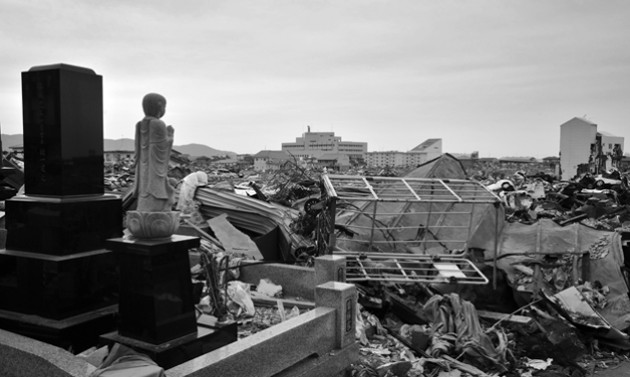
A translation of the Kyoto classic by David Jenkins and Yasuhiko Moriguchi
To understand
the world of today,
hold it up
to the world
of long ago
—Kamo-no-Chomei
[T]he times are calamitous, and it is scarcely less frightening to look back than forward. A horrific earthquake turns the world upside-down. A fire cuts a huge swathe through one of the world’s great cities, and no one will ever know exactly how many have perished. You are not safe in your neighborhood, nor even in your home, as heavily armed gangsters battle for turf, apparently with the connivance of the authorities. Future historians will see the age as a flowering of civilization and culture, yet the average citizen must endure poverty, overcrowding and the abstracted oppressiveness of an egregiously corrupt and incompetent government, characterized by a state of permanent office-seeking. A popular song goes, “… the era changes/ and we look to the end of the world…” A new era does indeed approach and bizarre suicide cults appear, exhorting their members to acts of spectacular self-destructiveness. The gulf between the rich and the destitute is accelerating, and it is sometimes hard to believe the moral depths to which some people will sink merely to survive.
So much for the good news. The bad news is that simmering civil unrest and intermittent outbreaks of street violence are prelude to outright war and the imposition of a military dictatorship which will last with very little change for seven hundred years.
The year is 1212 AD, the place is Kyoto and we owe a good deal of our first-hand knowledge of the above events to the brush of a reclusive scholar and poet, Kamo-no-Chomei. It was in that year that Chomei, by then elderly, completed his great masterpiece of poetic witness, Hojoki, in which he looked back from seclusion in the hills of eastern Kyoto to the city of his youth, when it was overtaken by a series of disastrous events. Other glimpses of the times are provided by contemporary verse.
The era Chomei was recalling was the late Heian Period (794-1192), in particular the 1170s and early 1180s, a time when the political power base of the country was to shift east from the court in Kyoto to the seat of the newly established Shogunate in Kamakura. At that time. Kyoto was visited by a fire, a tornado, an earthquake and a lingering famine and pestilence, the effects of all of which being compounded by government indifference and ineptitude.
As an act of witness — of a bearing of witness — the Hojoki is extraordinary enough. Chomei was an accomplished and publicly honored poet, who was able to rise through Court ranks and attract the approbation of his peers. Yet the social attitudes underlying the poetry of the day might be summarized by the words of the contemporary master Fujiwara Teika: “My ears are filled with news of uprisings and killings … I care nothing about such matters…” Chomei, on the other hand, clearly witnessed — went out of his way to see for himself — the events he reported. His language in conveying the flash of cinders through the air, or the gush of water from riven hillsides, or the putrid stench of corpses lying neglected in the streets of one of the most sophisticated capitals in the world, would be impossible otherwise.
Chomei, therefore, represents one of the earliest examples of literature as conscience, as the true action of a man of good faith. We may look to him as a progenitor of those who through the centuries have come to embody Witness as Resistance, refusal to accept complicity as collaborator in an infamous status quo, but rather to art in alliance with the future against the present.
Chomei in no way rose up against his contemporary world, but rather has left his outrage and contempt as a scourge for future generations to wield.
However, if that were Chomei’s entire intention we might consider him radical enough. But he was a great poet, and the language of the Hojoki tells us as much about language as it does about the contents of Chomei’s heart.
Further, Chomei’s introspections in the latter half of the work — which describes his retreat from the world, into smaller and smaller huts — tell us as much about good faith as about his actions. For towards the end of his chronicle, Chomei seems to step forward out of the text itself and address us directly. He questions his retreat from the world, and his attachment to the gimcrack little hovel he now inhabits.
He appears to us as a ghostly figure reminding us that our own acts of Witness, or even Resistance, may not necessarily be assured of Good Faith because we wish it so. Chomei’s insistence on this leads him to question not only his integrity but his very sanity, in a passage in which we moderns can recognize thrilling genius. He has bridged the centuries to speak, quite directly, to us.
Thus the Hojoki sails on into the future, as do the impassioned works of Witness to the horrors and oppressions of our “modern” age. Future generations may see in them the inspiration to berate not us but their own contemporaries.

Hojoki: Visions of a Torn World, translated by David Jenkins and Yasuhiko Moriguchi with paintings by Michael Hofmann, was published by Stone Bridge Press in 1996. Extracts of their translations of Ryojin-hisho and Kanginshu, as well as from The Gates of Night: Six Songs from the Noh,” have appeared in previous issues of Kyoto Journal.

Header image taken in Ishinomaki, destroyed by the March 11th tsunami, by John Einarsen